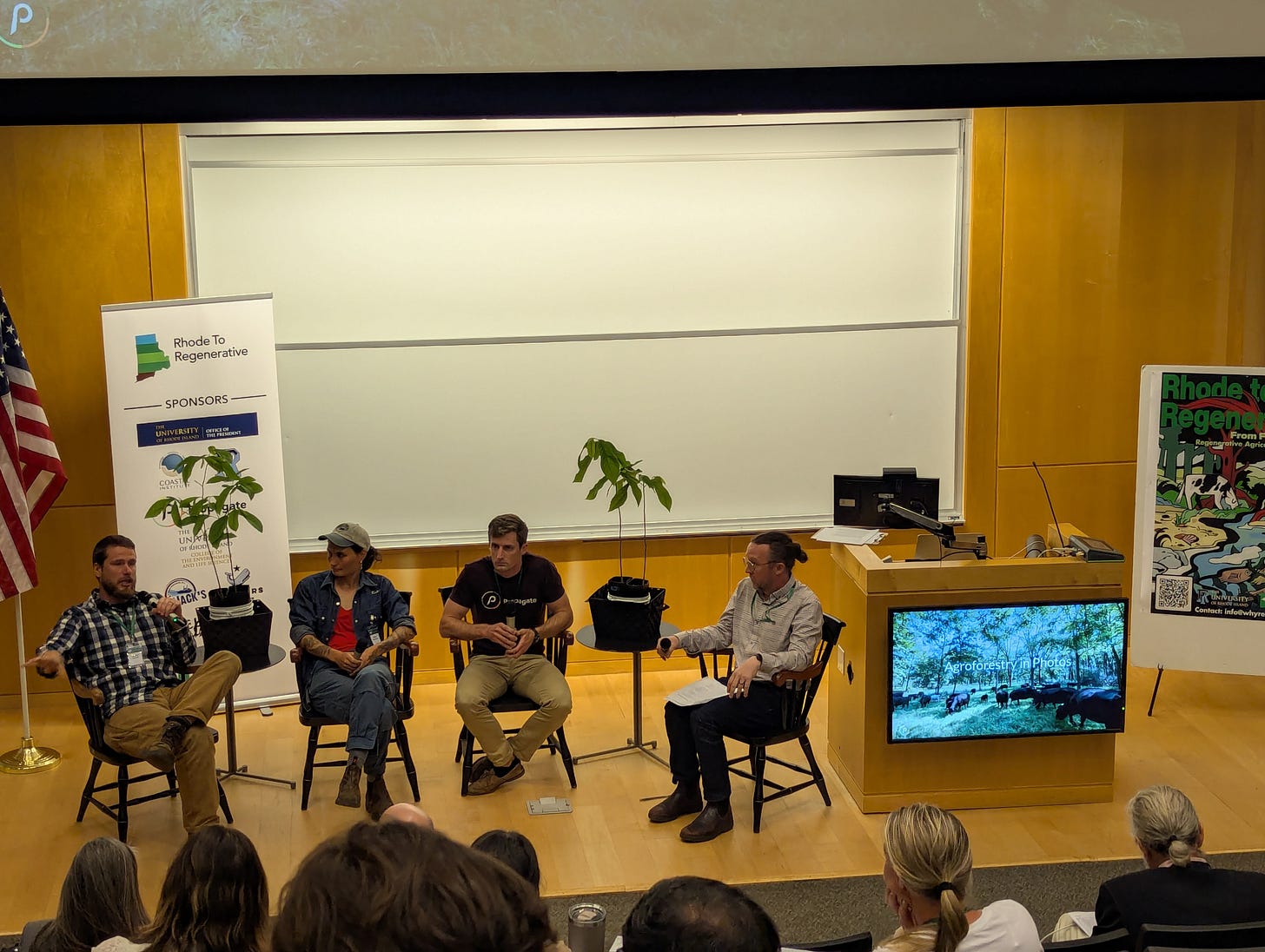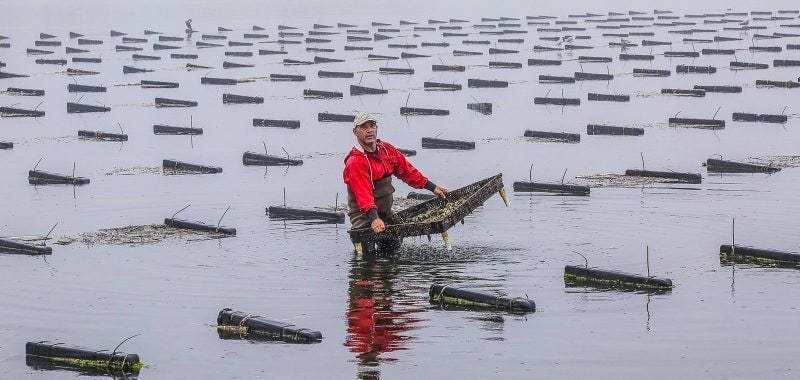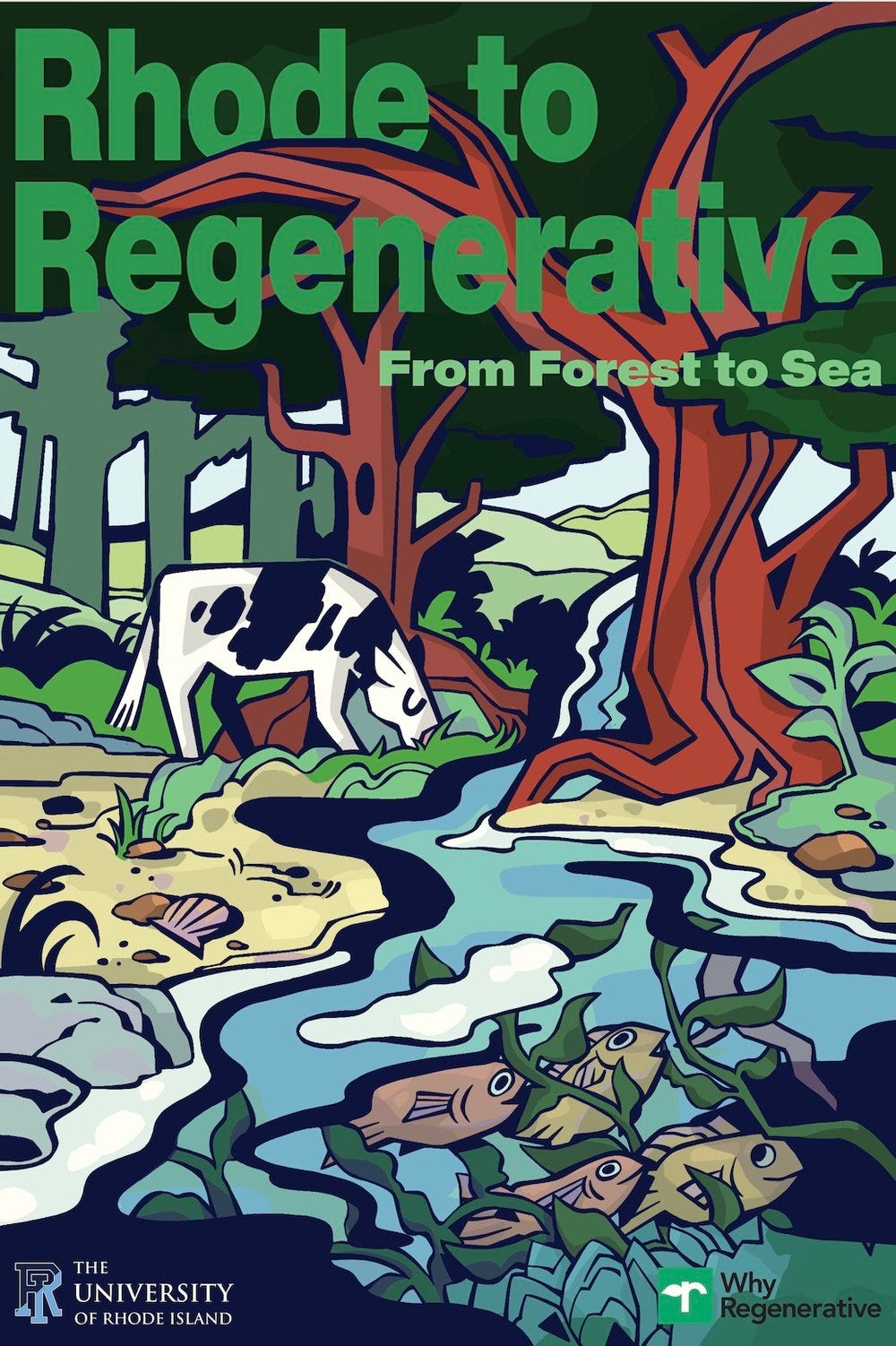Farming the Future by Land and Sea
Exploring the emerging connections between regenerative agriculture and aquaculture—and why they matter now more than ever.
This week, I had the chance to attend the University of Rhode Island’s inaugural Rhode to Regenerative conference — a new gathering focused on regenerative agriculture and aquaculture, and the deeply intertwined systems of land and sea.
What is regenerative ag., anyway?
At its core, regenerative agriculture is about healing the land while growing food. It goes beyond sustainability by aiming to improve soil health, increase biodiversity, and restore natural ecosystems. Regenerative practices like cover cropping, no-till farming, rotational grazing, and integrating trees into pasture, help rebuild resources instead of depleting them. It's rooted in reciprocity: giving back more than we take. And when done right, these same principles can apply to the ocean too.
Hosted in Kingston, Rhode Island, the event brought together farmers, fishers, scientists, policy advocates, and technical assistance providers to explore what regeneration means across ecosystems and industries. From silvopasture in New England woodlands to oyster reef restoration in estuaries, these sessions weren’t just about the science or the policy; they were about the people. People trying, testing, adapting, and growing new ways to care for land and water in tandem.
A big thanks to Azure Cygler of URI’s Coastal Resources Center and Rhody Wild Sea Gardens for hosting me. I’ve been volunteering on her oyster restoration project — more on that next week — but being part of this event added even more layers to what I’m learning from her exciting work.
From Kelp Relish to Carbon Credits: Conversations That Matter
At the conference, I joined sessions on everything from silvopasture establishment to oyster aquaculture permitting. I reconnected with familiar faces like Jon McGee from New England Sea Farms (who’s deep in kelp bioplastics these days) and met new folks pushing sustainable ideas forward. The energy was optimistic but clear-eyed about what it takes to build real systems rooted in regenerative practices.

Here are some of the highlights that stuck with me:
1. The demand gap is real—but solvable.
In a session on expanding demand for seaweed and shellfish, we heard from growers like Oliver Dixon of Blue Acres and Brian Pinsky of 401 Oysters. The consensus: local is powerful. As Zach Roch of Roch’s Fresh Foods said, consumers care about foods that are, “Grown here, sourced here, stored here, eaten here.” Value-added products like kelp relish (shoutout to Charlie Westcott!) and biostimulants are growing in popularity. Still, many farmers face slow ROI (return on investment), small or fragmented ocean leases, and underdeveloped consumer markets. Coop models and restaurant partnerships are helping bridge that gap.
2. Floating gear fights are heating up.

Pushback on floating cages for oyster farming came up again and again. One audience member joked they should just paint the buoys to look like lobster traps to combat the “nostalgic” vs. “eyesore” debate. It was a laugh, but it got to the heart of a growing tension. Visibility in the water often leads to NIMBY (Not In My Back Yard) resistance, even when the environmental benefits are clear. Again and again, coastal land owners show up at town meetings to fight against regenerative ocean practices in favor of the aesthetic desire to not see the buoys holding up the — mostly underwater — oyster cages. Some are advocating for expanding “right to farm” laws to the ocean to support regenerative aquaculture.

3. Kelp lines bring the fish… and the birds.
One of the most striking images came from a farmer who said birds now follow her boat out to the farm. Why? The kelp lines she added to her oyster gear created such a rich habitat that fish are flourishing and the ecosystem is responding. Kelp acts like an underwater forest, offering shelter, food, and spawning grounds for marine life. As the fish return, so do the birds, drawn by the promise of scattering fish when farmers bring up the oyster cages. These living systems are more interconnected than we often realize. A single line of seaweed can ripple outward, regenerating not just water quality or biodiversity, but also a sense of balance between human livelihoods and ecological restoration. These moments are powerful reminders that farming the ocean, done right, can be healing not just for the planet, but for our relationship to it.
4. Everyone wants in on carbon markets, but data is lacking.
There’s strong interest in carbon and biodiversity credits, but the metrics don’t yet match the ambition. For those who may not know, these “ carbon credits” are essentially tradable units that represent environmental benefits like removing a ton of carbon from the atmosphere or restoring a critical habitat. In theory, they let businesses or governments offset their environmental impact by investing in projects that do measurable good. But here’s the catch: how do we quantify something as complex and dynamic as ecosystem restoration? What counts, and who decides? Without rigorous, equitable standards, there’s a risk of overselling impact or overlooking the communities actually doing the work. These are the kinds of questions that need more investment in both science and justice.
5. Restoration is part of the business model.
Sally McGee from The Nature Conservancy spoke about SOAR (Supporting Oyster Aquaculture and Restoration), a program that emerged in direct response to the COVID-19 pandemic. When restaurant shutdowns devastated the oyster industry, many shellfish farmers were left with millions of unsold oysters and no clear path forward. SOAR was designed to support struggling growers by purchasing surplus oysters and using them to rebuild wild reefs. SOAR built its model off Rhode Island’s NRCS (Natural Resources Conservation Service) approach, blending ecological restoration with economic relief and resilience. And while Rhode Island may be the smallest state in the country, it’s been quietly leading this work. The local NRCS office under the federally-run USDA was one of the first to adapt land-based conservation tools to support marine growers. These efforts helped lay the groundwork for programs like SOAR. Just another reason why federal funding matters! We must support legislators working to restore and protect grant programs currently under attack by the Trump administration.
Regeneration Is a Relationship
What stood out most from this conference wasn’t any single session. It was the through-line: regeneration isn’t just a buzzword. It’s a mindset. A commitment to reciprocity. To work that doesn’t just reduce harm but repairs, rebuilds, and reimagines.
We need systems that feed people and ecosystems. We need public policies that reflect the interconnectedness of watersheds and coastal economies. We need funding models that don’t penalize the people doing the most with the least.
And maybe most of all, we need each other. The growers, the scientists, the policy folks, the eaters, the dreamers. This is not work we can do alone.
To the team behind Rhode to Regenerative, thank you for gathering us. I’m already looking forward to the next one. If you were at the event or want to share your thoughts on ocean farming and regeneration — I’d love to hear what resonated with you.
Stay tuned for next week’s post on Rhody Wild Sea Gardens and oyster restoration in action!






